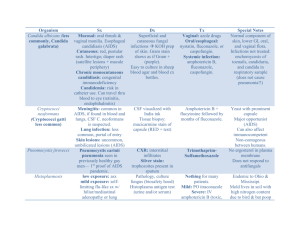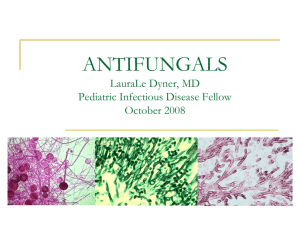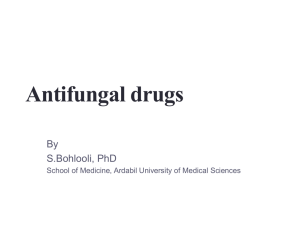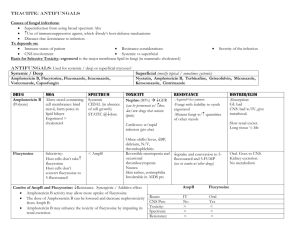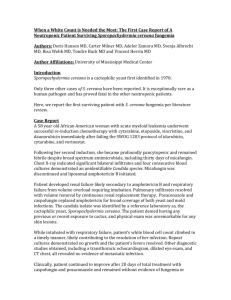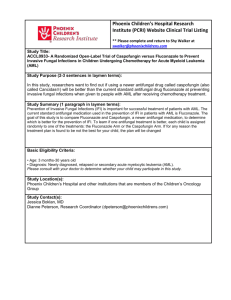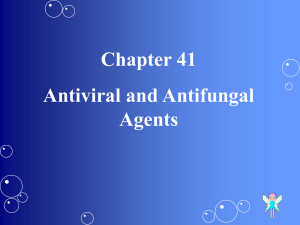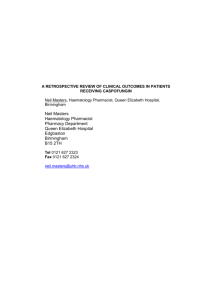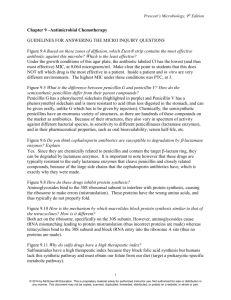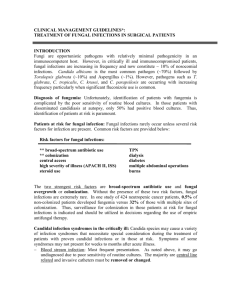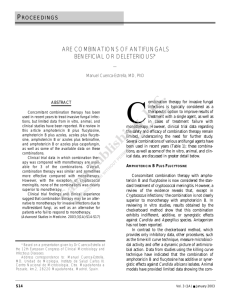antifungal_Kubin
advertisement
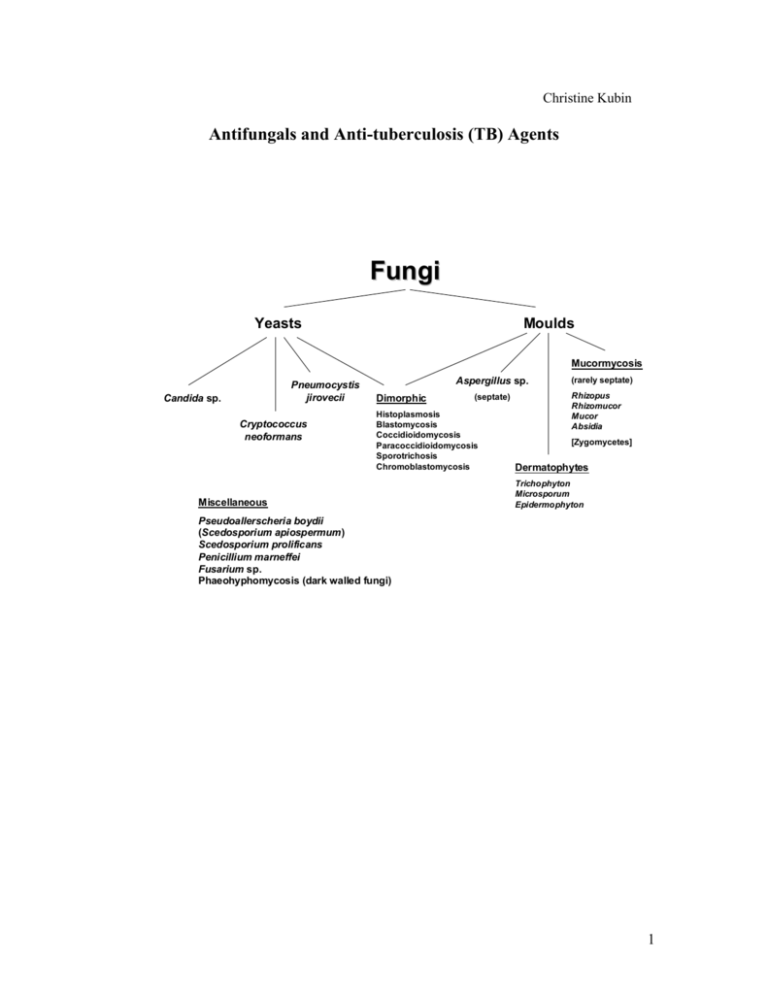
Christine Kubin Antifungals and Anti-tuberculosis (TB) Agents Fungi Yeasts Moulds Mucormycosis Pneumocystis jirovecii Candida sp. Cryptococcus neoformans Aspergillus sp. Dimorphic (septate) Histoplasmosis Blastomycosis Coccidioidomycosis Paracoccidioidomycosis Sporotrichosis Chromoblastomycosis Miscellaneous (rarely septate) Rhizopus Rhizomucor Mucor Absidia [Zygomycetes] Dermatophytes Trichophyton Microsporum Epidermophyton Pseudoallerscheria boydii (Scedosporium apiospermum) Scedosporium prolificans Penicillium marneffei Fusarium sp. Phaeohyphomycosis (dark walled fungi) 1 Antifungals Voriconazole N N N OH CH 3 N F F N F Caspofungin POLYENES (amphotericin B, nystatin) AMPHOTERICIN B A. Amphotericin B is produced by Streptomyces nodosus (aerobic actinomycete). B. Mechanism of action a. The mechanism of action focuses on the fungal cytoplasmic membrane and binding to sterols, specifically ergosterol. Amphotericin B increases cell membrane permeability via pore and channel formation resulting in fungal cell death from loss of intracellular molecules. C. Resistance a. Resistance to amphotericin is rare. Resistant strains appear to show slower growth rates and less virulence in vitro. Two mechanisms are possible. i. Resistant mutants replace ergosterol with other precursor sterols. ii. Failure of amphotericin to penetrate the fungal cell wall. 2 D. Spectrum a. Amphotericin is the most broad spectrum antifungal and is considered the “gold standard” for the treatment of a variety of fungal infections. Amphotericin has useful clinical activity against Candida sp. (although C. lusitaniae is relatively resistant to amphotericin B), Cryptococcus neoformans, Blastomyces dermatitidis, Histoplasma capsulatum, Sporothrix schenkii, coccidiodomycosis, paracoccidiodes, Aspergillus sp., Penicillium, mucormycosis. [G&G p. 1298] E. Pharmacokinetics a. Amphotericin is available only as an injection for intravenous (IV) use. An oral suspension may be compounded for treatment of oropharyngeal and esophageal candidal infections. When given orally it has negligible gastrointestinal absorption and is not reliable for the treatment of systemic infections. b. After IV administration, most of the drug leaves the circulation quickly and is stored in the liver and other organs and reenters the circulation slowly. It is extensively bound to tissues. As a result, the half-life of amphotericin is prolonged (~15 days) and it can be detected in the body up to 7 weeks after discontinuing therapy. About 2-5% of each dose is excreted unchanged in the urine. Most of the drug is degraded in the body. Accordingly, no dose adjustment is necessary in patients with renal and/or hepatic dysfunction. c. Amphotericin achieves its highest concentrations in the liver and spleen with less in the kidneys and lungs. It does not appear to penetrate cerebrospinal fluid, brain, pancreas, muscles, bone, vitreous humor, normal amniotic fluid, and bronchial secretions well. Concentrations are increased with inflammation where levels may approach 67% of serum levels in areas like the pleura, peritoneum, and joints. F. Formulations a. Amphotericin B deoxycholate: i. Amphotericin is insoluble in water and is formulated as a complex with the bile salt deoxycholate. This is “conventional” amphotericin B. b. Lipid formulations of amphotericin Lipid formulations of amphotericin are advantageous with respect to toxicities. While they are still nephrotoxic, they cause less nephrotoxicity compared to conventional amphotericin. In addition, Ambisome appears to be associated with less infusion related reactions compared to the other lipid products. Their use, historically, however, is limited by cost as they are often 30-50 times more expensive than conventional amphotericin. No difference in efficacy has been shown between the lipid products and conventional amphotericin. i. Amphotericin B colloidal dispersion (ABCD, Amphotec) is a colloidal dispersion containing equal amounts of amphotericin B and cholesteryl sulfate. ABCD particles are disk shaped. ii. Amphotericin B lipid complex (ABLC, Abelcet) contains dimyristoylphosphatidylcholine and dimyristoyl phosphatidylglycert in a 7:3 mixture with ~35 mol% amphotericin in a ribbon-like sheet structure. iii. Liposomal amphotericin B (Ambisome) is a unilamellar liposome (one molecule ampho B per 9 molecules lipid). The lipid contains phosphatidylcholine, cholesterol, and distearoylphosphatidylglycerol in a 10:5:4 molar ratio. 3 Factor Amphotericin B deoxycholate Amphotericin B colloidal dispersion (ABCD, Amphotec) Amphotericin B lipid complex (ABLC, Abelcet) Liposomal amphotericin B (Ambisome) Particle Micelle Lipid disks Ribbons, sheets Liposomes, small unilamellar vesicles Size (nm) <25 100 500-5000 90 Carrier deoxycholate cholesteryl sulfate dimyristoylphosphatidyl choline and dimyristoyl phosphatidylglycert phosphatidylcholine, cholesterol, and distearoylphosphatidylglycerol Infusion related toxicity High High Moderate Mild Nephrotoxicity ++++ Serum concentrations compared to conventional amphotericin Tissue concentrations compared to conventional amphotericin Liver: Lungs: Kidney: Liver: Lungs: Kidney: Liver: Lungs: Kidney: 0.5-1.5 mg/kg/day 3-4 mg/kg/day 5 mg/kg/day 3-5 mg/kg/day $37 $480 $820 $1300 Dosage Estimated cost/day (Red Book 2002) G. Toxicities a. Nephrotoxicity i. All amphotericin products cause some degree of nephrotoxicity. This manifests as a dose-dependent decrease in glomerular filtration rate via a direct vasoconstrictive effect on afferent renal arterioles. Other effects include potassium, magnesium, and bicarbonate wasting, and a decrease in epoetin production. Permanent renal failure is related to the total dose and is due to destruction of renal tubular cells, disruption of tubular basement membrane, and loss of functioning nephron units. ii. Risk factors for nephrotoxicity include concomitant nephrotoxic drugs (e.g. cyclosporine, aminoglycosides), hypotension, intravascular volume depletion, renal transplant, and other pre-existing renal conditions. iii. Nephrotoxicity may be reduced through saline loading (500 mL to 1 L) with each dose. This prehydration depends on the ability of patients to tolerate fluids (may not be possible with heart failure, renal failure, and other fluid overload states). Lipid products are less nephrotoxic, but can still themselves cause nephrotoxicity. b. Electrolyte abnormalities i. Renal tubular acidosis and renal wasting of potassium, magnesium, and phosphate is commonly seen during treatment with amphotericin and for 4 several weeks after treatment is discontinued. Close monitoring (daily) and electrolyte supplementation are necessary. c. Infusion related reactions (IRRs) i. Infusion related reactions are common early in the course of amphotericin. Reactions are most severe with the first 3-5 doses and usually subside with continued use and premedications. Chills, fever, and tachypnea may occur during the infusion. Premedicating with diphenhydramine and acetaminophen for all doses can diminish reactions and is recommended. If severe shaking shills (rigors) occur, infusions are temporarily discontinued and meperidine administered to shorten the rigor. These reactions are expected and should not be mistaken for anaphylaxis. Allergic reactions can occur, but are extremely rare. More continued severe reactions may require premedication with hydrocortisone. IRRs appear less commonly with the Ambisome formulation. d. Other i. Nausea and vomiting are common. Thrombophlebitis may occur with peripheral administration. A normocytic normochromic anemia may occur and is associated with decreased epoetin levels. H. Clinical Uses a. Candidiasis (azole resistant strains too), cryptococcal meningitis, mucormycosis, invasive aspergillosis b. Empiric therapy in patients with febrile neutropenia c. Intrathecally for coccidiodal meningitis d. Intraocular injections for fungal endophthalmitis e. Bladder irrigation for fungal cystitis f. Oral suspension for oropharyngeal and esophageal candidiasis FLUCYTOSINE A. Flucytosine is a fluorinated pyrimidine related to fluorouracil. It is 5-FC (5fluorocytosine). B. Mechanism of action a. Flucytosine is deaminated to 5-FC. It is then converted to 5-fluorodeoxyuridylic acid monophosphate which is a noncompetitive inhibitor of thymidylate synthetase and interferes with DNA synthesis. b. Mammalian cells do not convert flucytosine to fluorouracil, so flucytosine is selective for fungi. C. Mechanisms of resistance a. Drug resistance arises during therapy, especially monotherapy. The mechanism can be loss of the permease necessary for cytosine transport or decreased activity of UMP pyrophosphorylase or cytosine deaminase. D. Spectrum a. Flucytosine has useful activity against Cryptococcus neoformans, Candida sp., and chromomycoses. E. Pharmacokinetics a. Flucytosine is available for oral administration only. Absorption from the GI tract is rapid and complete. It is excreted renally with ~90% excreted unchanged in the urine and thus, requires dose adjustment in patients with renal disease. 5 b. Flucytosine penetrates well into the CSF (~75% of serum levels) and penetrates well into aqueous humor, joints, bronchial secretions, peritoneal fluid, brain, bile, and bone. c. The usual half-life is ~3-6 hours, but may be increased to ~200 hours in patients with renal failure. d. Serum concentration monitoring is recommended, if feasible. F. Toxicities a. Bone marrow suppression i. Bone marrow suppression is the most common and severe toxicity associated with flucytosine. It appears to be dose-related and associated with concentrations >100-125 mcg/mL. Leukopenia and thrombocytopenia are the usual manifestations. Risk factors include underlying hematologic disorders and concomitant bone marrow suppressive drugs. b. GI disturbances i. Nausea, vomiting, and diarrhea are also common. G. Clinical Uses a. Flucytosine may be clinically useful in cryptococal, candidal, and chromomycoses, but it is not a drug of choice. It is not as efficacious as other agents and is associated with the development of resistance. It is usually only used in combination with other agents, most commonly amphotericin. AZOLES Many older azole antifungals (clotrimazole, miconazole) are available in over the counter (OTC) topical preparations for the treatment of fungal infections such as athlete’s foot, vaginal candidiasis, etc. The systemic antifungals more commonly used will be discussed here. These are ketoconazole, fluconazole, itraconazole, and voriconazole. These azole antifungals are separated into two classes, imidazoles (ketoconazole) and triazoles (itraconazole, fluconazole, voriconazole). Both classes have the same mechanism of action, but triazoles appear to have less of an effect on human sterol synthesis than the imidazoles (improved adverse effect profile). The azoles inhibit C-14 demethylation of lanosterol in fungi by binding to one of the cytochrome P450 enzymes, which leads to the accumulation of C-14 methylsterols and reduced concentrations of ergosterol, a sterol necessary for the fungal cell membrane. Azole resistance has emerged gradually during prolonged therapy and has been associated with treatment failures. There is some degree of cross resistance among the azoles. There are three possible mechanisms of resistance: a. Accumulation of mutations in ERG11, the gene encoding for the C14-sterol demethylase (primary mechanism) b. Increased azole efflux by both ATP binding cassette (ABC) and major facilitator superfamily (MFS) transporters c. Increased production of C14-sterol demethylase. It is important to understand the drug’s activity against specific fungal organisms, especially among Candida species. The azoles differ in their activity against the different Candida species. 6 In vitro Susceptibility Testing of Candida sp. (NCCLS) (mcg/mL) Drug Susceptible (S) Susceptible DoseDependent (S-DD) Resistant (R) Fluconazole 8 16-32 64 Itraconazole 0.125 0.25-0.5 1 Flucytosine 4 8-16 (I) 32 Susceptibility of Candida sp. to Antifungal Agents Candida species Fluconazole Itraconazole Voriconazole (not standardized) Flucytosine Amphotericin Caspofungin (not standardized) C. albicans S S S S S S C. tropicalis S S S S S S C. parapsilosis S S S S S S to R C. glabrata S-DD to R S-DD to R S S S-I S C. krusei R S-DD to R S I-R S-I S C. lusitaniae S S S S S to R S KETOCONAZOLE (Nizoral) A. Ketoconazole is a synthetic imidazole antifungal. With the introduction of more broad spectrum and less toxic azole antifungals, it is rarely used. B. Spectrum a. The drug has been used to treat mucocutaneous candidiasis, coccidiodomycosis, histoplasmosis, paracoccidiodomycosis, and blastomycosis in nonimmunosuppressed patients. It is not effective for aspergillosis and mucormycosis. C. Pharmacokinetics a. Ketoconazole is only available for oral administration and absorption varies between individuals. An acidic environment is required for absorption (affected by antacids and H2-histamine antagonists). b. Ketoconazole is liver metabolized and is excreted as inactive drug in bile, and to a small extent, in urine. The usual half-life is ~8 hours. Moderate hepatic dysfunction has no effect on ketoconazole blood levels. Ketoconazole is an inhibitor of CYP3A4 and its own metabolism is affected by inducers of the cytochrome P450 enzyme system. c. Ketoconazole levels in the CSF are minimal (<1%) compared to plasma. D. Toxicities a. GI disturbances i. Dose dependent nausea, vomiting, and anorexia are the most common adverse effects. b. Endocrinopathies 7 i. Ketoconazole inhibits steroid biosynthesis in humans as it does in fungi and as a result, endocrinopathies may develop. Specifically, it causes a dose-dependent decrease in testosterone synthesis and can suppress androgen production. Gynecomastia and oligospermia in men and menstrual irregularities in women have been seen. c. Hepatotoxicity i. Hepatotoxicity may also occur but is less common. The majority of cases occur in the first three months of therapy. E. Clinical Uses a. Ketoconazole use is very limited for fungal infections and has largely been replaced with itraconazole. Topical ketoconazole shampoo is the most commonly used formulation of ketoconazole. ITRACONAZOLE (Sporanox) A. Itraconazole is a triazole antifungal with a broader spectrum of activity, a more desirable pharmacokinetic profile, and less toxicity than ketoconazole. It is, however, still limited by its pharmacokinetics, drug interactions, and toxicities. B. Spectrum a. blastomycosis, histoplasmosis, coccidiodomycosis, paracoccidiodomycosis, sporotrichosis, ringworm (including onychomycosis), tinea versicolor, and aspergillosis C. Pharmacokinetics a. Until recently, itraconazole was only available in an oral formulation associated with pharmacokinetic problems. Due to variability in concentrations achieved following oral dosing and association with treatment failures, the use of this agent has been limited. b. Itraconazole is water insoluble. It is available in oral capsules and an oral solution. The oral solution is coformulated with cyclodextrin to improve solubility and absorption (30% greater than capsules). Oral absorption of the capsules is improved with food while the solution is best absorbed on an empty stomach. c. Tissue, pus, and bronchial secretion concentrations are generally higher than plasma levels. CSF and ocular levels are low. d. Itraconazole is primarily metabolized in the liver by CYP3A4 and also inhibits this enzyme system. As a result, it is subject to drug interactions and these should always be evaluated before initiating therapy. The half-life is ~30-40 hours and will be prolonged in patients with severe liver disease. e. The intravenous formulation of itraconazole is coformulated with hydroxypropyl-cyclodextrin to improve solubility. This cyclodextrin is excreted renally, unlike itraconazole, and accumulates in patients with renal dysfunction. Intravenous use is not recommended in patients with CrCL <30 ml/min without evaluation of risk/benefit. D. Toxicities a. GI disturbances i. Dose-related nausea, diarrhea, and abdominal discomfort are the most common. b. Hepatotoxicity c. Thrombophlebitis i. Significant thrombophlebitis is associated with the intravenous formulation when administered peripherally. Increased fluid dilution volume is often necessary. 8 d. Negative inotrope i. Intravenous administration in dogs and humans has resulted in negative inotropic effects. Itraconazole should not be administered to patients with congestive heart failure or patients with ventricular dysfunction for the treatment of onychomycosis. E. Clinical Uses a. Treatment of pulmonary and extrapulmonary blastomycosis b. Histoplasmosis, including chronic cavitary pulmonary disease and disseminated, nonmeningeal histoplasmosis c. Pulmonary and extrapulmonary aspergillosis, usually in patients refractory of or who are intolerant to amphotericin d. Empiric fungal therapy in patients with neutropenic fever FLUCONAZOLE (Diflucan) A. Fluconazole is the best tolerated and most widely used triazole antifungal. B. Spectrum a. candidiasis, Cryptococcus neoformans, coccidiodomycosis b. some activity against sporotrichosis, ringworm, histoplasmosis, and blastomycosis, but not as efficacious as itraconazole c. no activity against Aspergillus sp or mucormycosis C. Pharmacokinetics a. Fluconazole is available in both oral and intravenous forms. The oral formulation is very well absorbed from the GI tract and bioavailability is >80%. Oral absorption is not affected by pH. b. Fluconazole is mainly excreted renally with 60-75% of the drug appearing unchanged in the urine. Dose adjustment is necessary in patients with renal disease. c. Fluconazole penetrates well into saliva, sputum, urine and other body fluids including the CSF (~70% of plasma levels) and brain. d. Fluconazole is subject to a limited number of drug interactions including interactions with phenytoin, cyclosporine, warfarin, rifampin, rifabutin, sulfonylureas, tacrolimus, and warfarin. D. Toxicities a. Adverse effects are uncommon b. Nausea, vomiting, and anorexia may occur with higher doses c. Rare hepatotoxicity has occurred (usually with high, prolonged doses) E. Clinical Uses a. Commonly used for infections caused by susceptible Candida sp. (systemic, cutaneous, oropharyngeal, esophageal, intra-abdominal, vaginal, etc.) b. Has been used as initial treatment and maintenance of cryptococcal meningitis in HIV patients c. Fungal prophylaxis in neutropenic patients d. Coccidiodomycosis (meningitis and disseminated) VORICONAZOLE (Vfend) A. Voriconazole is the newest triazole antifungal. It is structurally related to fluconazole but expands on fluconazole’s clinical activity to include fluconazole-resistant Candida sp., Aspergillus sp., and rare molds (Scedosporium sp., Fusarium sp.). Like the other azoles, it appears fungistatic against yeast, but fungicidal against molds. Voriconazole is available orally with good bioavailability and has become an attractive option for long 9 term maintenance therapy for mold infections in immunosuppressed patients. The pharmacokinetic profile of voriconazole is greatly improved over itraconazole, but drug interactions and toxicity may still be problematic. B. Spectrum a. Candida sp. (including most fluconazole-resistant strains), Aspergillus sp., Blastomyces dermatitidis, Coccidiodes immitis, Histoplasma capsulatum b. Some strains of Pseudoallescheria boydii, Scedosporium apiospermum, Fusarium sp., Paecilomyces sp., Bipolaris sp., and Alternaria sp. c. Voriconazole is less active against Sporothrix schenkii C. Pharmacokinetics a. Voriconazole is available in both IV and oral formulations. The oral formulation is best absorbed on an empty stomach with >90% bioavailability. b. Voriconazole exhibits nonlinear pharmacokinetics in adults due to saturation of metabolism. A significant degree of interpatient variability in serum concentrations has been observed. In children, elimination is linear and higher doses are required to attain similar concentrations as in adults. c. Voriconazole has a large volume of distribution and distributes well into the CSF (~50% of plasma concentrations). d. Voriconazole is metabolized in the liver via the CYP450 system, specifically CYP2C9, CYP3A4, and CYP2C19. Drug interactions are of major importance in the safe use of this agent and should be carefully evaluated. The usual half-life is ~6 hours. Dosage adjustment is necessary in patients with liver dysfunction. Contraindications Rifampin Rifabutin Sirolimus Barbiturates (long-acting) Carbamazepine Astemizole Cisapride Terfenadine Pimozide Quinidine Ergot alkaloids Dose Adjustment of Voriconazole Phenytoin Dose Adjustment and/or Monitoring of other Drugs No Dose Adjustment of Voriconazole or other Drugs Required Cyclosporine Tacrolimus Omeprazole Warfarin Phenytoin Sulfonylureas Statins Benzodiazepines Dihydropyridine CCBs Vinca alkaloids HIV PIs and NNRTIs Indinavir Mycophenolate mofetil Cimetidine Ranitidine Macrolide antibiotics Prednisolone Digoxin (other than indinavir) e. The intravenous formulation is formulated with sulfobutyl ether -cyclodextrin sodium (SBECD) to increase the solubility of voriconazole. SBECD, unlike voriconazole, is eliminated via the kidneys and as a result accumulates in patients with renal disease. Use is not currently recommended in patients with CrCL <50 ml/min without evaluation of the risk/benefit. D. Toxicities a. Visual disturbances i. Visual disturbances have been reported to occur in about ~30% of patients but rarely results in discontinuation of therapy. Symptoms occur early in therapy with the first few doses, usually begin within 30 minutes of a dose, and last for about 30 minutes. Visual effects include altered color discrimination, blurred vision, appearance of bright spots, and 10 photophobia. These effects are associated with changes in electroretinogram tracings, which normalize upon discontinuation of treatment. b. Hepatotoxicity i. Similar to other azoles, elevations in hepatic enzyme levels may occur with voriconazole. Most patients have asymptomatic elevations, but life threatening hepatitis has been described. These effects appear doserelated and resolve with discontinuation of therapy. c. Skin rashes i. Skin reactions associated with voriconazole have been reported. Most have been characterized as a photosensitivity reaction. E. Clinical Uses a. Primary or salvage therapy of invasive aspergillosis. b. Infections due to fluconazole-resistant Candida sp. c. Treatment of Pseudoallescheria/scedosporium and Fusarium sp. infections. d. Empiric antifungal therapy in patients with neutropenic fever e. Voriconazole may be useful in cryptococcosis, blastomycosis, coccidiodomycosis, and histoplasmosis, but clinical data is currently lacking to support routine use for these infections. ECHINOCANDINS CASPOFUNGIN (Cancidas) A. Caspofungin is the first in a new class of antifungals, called the echinocandins. Caspofungin differs from the other currently available antifungals by its mechanism of action, targeting the fungal cell wall rather than the fungal cell membrane. B. Mechanism of action a. Caspofungin is a noncompetitive inhibitor of the (1,3)-D-glucan synthase enzyme which blocks the synthesis of (1,3)-D-glucan. (1,3)-D-glucan is an essential component of the cell wall of numerous fungal species. The chains of (1,3)-D-glucan form a solid three-dimensional matrix, which gives the wall its 11 C. D. E. F. G. shape and mechanical strength. This mechanism is both fungistatic and fungicidal. The fungistatic effect correlates to decreased cell wall synthesis and reduction in fungal growth. The fungicidal effect results from changes to the integrity of the cell wall. Mammalian cells do not contain (1,3)-D-glucan so caspofungin should be selective against fungal cells. Mechanisms of resistance a. Very little is known about resistance with the echinocandins. Potential mechanisms demonstrated in vitro include the following: i. mutations in the FKS gene coding for the catalytic subunit (Fks p) of (1,3)-D-glucan synthase which binds intracellular UDP-glucose and a regulatory subunit Rho 1 p (binds intracellular GTP) ii. mutations in the RHO 01 gene coding for the regulatory subunit of (1,3)-D-glucan synthase Spectrum a. Active primarily against Candida sp. (fungicidal), including azole resistant or amphotericin resistant strains, and Aspergillus sp. (fungistatic). b. Not active against Cryptococcus neoformans. c. Caspofungin activity against filamentous fungi varies. In vitro, caspofungin is active against Paecilomyces variotii, but not Paecilomyces lilacinus and is active against Scedosporium apiospermum, but not Scedosporium prolificans. d. Caspofungin is not active against Fusarium sp and mucormycosis. e. It is active against Blastomyces dermatitidis and Histoplasma capsulatum, but Sporothrix schenckii is less susceptible. Pharmacokinetics a. Caspofungin is only available as an IV formulation. The oral bioavailability is limited. b. After administration in animal studies, caspofungin demonstrated high levels in the kidney, liver, spleen, and lungs. Lower levels were measured in the brain. c. Caspofungin is mainly eliminated in the urine and the feces as metabolites. Metabolism of caspofungin is thought to be independent of the CYP450 system and caspofungin does not inhibit CYP450 enzymes. Plasma clearance is primarily determined by the rate of distribution into tissues. The elimination half-life is ~9-11 hours. d. Caspofungin is not metabolized by CYP450, but its concentrations are reduced during concomitant administration with CYP450 inducers (e.g. rifampin). e. The caspofungin maintenance dose should be reduced in patients with hepatic dysfunction. Toxicities a. Caspofungin is extremely well tolerated with little to no adverse effects. b. The most frequent adverse events seen in clinical trials were fever, flushing, nausea, headache, vomiting, and infusion-related phlebitis (<3%). c. Elevations in serum transaminases may rarely occur. Clinical Uses a. Caspofungin is useful for the treatment of infections due to Candida sp., especially azole and amphotericin resistant strains. b. Caspofungin is approved for use in aspergillosis as salvage therapy. c. Empiric antifungal therapy in patients with neutropenic fever d. Less or limited efficacy has been shown for other pathogens. e. Due to its unique mechanism of action against the fungal cell wall, caspofungin has been investigated and has proven clinically useful in combination with 12 amphotericin or voriconazole for synergy in the treatment of severe, invasive fungal infections (e.g. invasive aspergillosis). Fungal cell wall components Fibrous (1,3) Glucan 1-6 Branched 1-6 Tail Glucan Surface-Layer Mannoprotein Chitin Entrapped Mannoprotein Glycosyl Phosphatidylinositol “(GPI) Anchor” (to mannoproteins) Plasma Membrane Plasma Membrane (phospholipid bilayer) Regulatory Subunit (GTPase) Catalytic subunit GTP 1,3) Glucan Synthase Enzyme Complex Non-competitive Inhibition by: Lipopeptide Class of UDP glucose Antifungals (Enchinocandins, Pneumocandins, Papulacandins) 1. Adapted from: Kurtz, MB, ASM News, Jan 98, Vol 64, No 1, pp. 31-9. 2. Walsh, TJ, et al, The Oncologist, 2000, 5;120-135 3. Module 1, Introduction to Medical Mycology, Merck & Co. Inc, , 2000, pp 811. Continuous fibrils of Glucan Ergosterol Chitin Synthase 13 Anti-tuberculosis (TB) Agents The primary goals of antituberculous therapy are to kill tubercle bacilli rapidly, prevent the emergence of drug resistance, and eliminate the persistent bacilli from the host to prevent relapse. Drugs used in the treatment of tuberculosis can be divided into two major categories: “first-line” agents and “second-line” agents. First-line agents combine the greatest level of efficacy with an acceptable degree of toxicity. Second-line agents are associated with less efficacy, greater toxicity, or both. Antituberculous drugs differ in their mechanism of actions and in their delivery to tuberculous lesions. All first line agents, except ethambutol, are bactericidal. Four of the first-line agents (INH, rifampin, streptomycin, and ethambutol) are active against large populations of tubercle bacilli in cavities. Streptomycin, other aminoglycosides, and capreomycin penetrate cells poorly and are inactive at acidic pH. Pyrazinamide is active only in acidic environments Slowly replicating organisms in necrotic foci are killed by rifampin and less by INH . 14 Christine Kubin, Pharm.D., BCPS Antifungal/AntiTB Agents First-line Drugs DRUG Isoniazid (INH) INH is indicated for all forms of TB. Rifampin Rifampin is indicated for all forms of TB. Pyrazinamide (PZA) PZA is a required component of a 6month short course x 2 months. Ethambutol Ethambutol is commonly used as the fourth drug in RIPE and often in regimens with isolates resistant to INH or rifampin. MECHANISM OF ACTION MECHANISM OF RESISTANCE - inhibits mycolic acid synthesis, an important component of mycobacterial cell walls - bactericidal against actively growing MTb and bacteriostatic against nonreplicating organisms - low level resistance is associated with point mutations or short deletions in the catalase-peroxidase gene (katG) - high level resistance is associated with major deletions within the gene with moss of enzymatic activity - resistance may also develop in a second gene involved in mycolic acid synthesis (inhA) - well absorbed orally or IM - CSF levels ~20% of plasma levels and higher with inflamed meninges - metabolized in the liver by Nacetyltransferase (“slow” acetylators exhibit higher levels of INH) - consider reducing the dose in “slow” acetylators with severe hepatic dysfunction - serum transaminases (AST, ALT) (12-15%) - hepatotoxicity (1%) - peripheral neuropathy - burning, tingling, numbness - coadminister vit B6 - alcoholics, children, diabetics, and malnourished at risk - rifampin - risk of hepatotoxicity (2030%) - inhibits DNAdependent RNA polymerase - bactericidal - resistance results from a point mutation or deletion within the region encoding the -subunit of RNA polymerase (rpoB) - well absorbed orally - CSF levels ~50% of plasma levels with inflamed meninges - deacetylated in the liver to an active form which undergoes biliary excretion and enterohepatic recirculation - Severe liver dysfunction requires a dosage reduction - in hepatic enzymes (AST, ALT, bilirubin, alkaline phosphatase) (10-15%) - hepatotoxicity (1%) - rash, GI disturbances - watch for RUQ pain, dark urine, jaundice - alcoholics at risk - interacts with > 100 drugs - ALWAYS THINK DRUG INTERACTIONS - protease inhibitors - orange discoloration of body fluids - this includes urine, tears, sweat, soft contact lenses, etc. - DO NOT COADMINISTER - rifampin concentrations of these drugs when coadministered - flu-like syndrome - fever, joint pain, muscle cramps - unknown mechanism of action - bactericidal with optimal activity against semidormant organisms in an acidic environment - resistance results from mutations in the gene encoding pyrazinamidase (pncA) which converts PZA to the active form of pyrazinoic acid - inhibits arabinosyl transferase enzymes involved with synthesis of arabinogalactan and lipoarabinomannan within the cell wall - bacteriostatic - resistance results from point mutations in the arabinosyl transferase enzyme EmbB, which is coded for by the embB gene PHARMACOLOGY - well absorbed orally - achieves adequate levels in the CSF - metabolized in the liver but metabolites are excreted by the kidneys - dosage modification in renal dysfunction necessary - well absorbed (~75-80%) - distributes into the CSF - predominantly excreted via the kidneys - dosage reduction necessary in renal dysfunction ADVERSE EFFECTS Comments… - watch for RUQ pain, dark urine, jaundice - discourage alcohol use DRUG INTERACTIONS - phenytoin - fluconazole, itraconazole, warfarin, digoxin, metoprolol, quinidine, verapamil, oral contraceptives, cyclosporine, diazepam, haloperidol, methadone, phenytoin, sulfonylureas Comments… - watch for mental status changes, nystagmus, and ataxia - nausea/vomiting - hepatotoxicity ( liver enzymes) - hyperuricemia - neuropathy (optic neuritis) - hyperuricemia - watch for RUQ pain, dark urine, jaundice - preexisting liver disease and higher doses at risk - potential for exacerbation of gout - complaints of blurry vision or inability to see the color green (more common at higher doses) - potential for exacerbation of gout - rash 15 Christine Kubin, Pharm.D., BCPS Antifungal/AntiTB Agents Streptomycin Streptomycin is used as the 4th drug in patients at significant risk of drug resistance or in regimens with known drug resistance. - inhibits protein synthesis - bactericidal - resistance associated with mutational changes involving ribosomal binding protein or the ribosomal binding site (gene rpsL) (16-S ribosomal RNA gene) - administered IV or IM - does not reach reliable concentrations in the CSF - eliminated via the kidneys - dosage reduction necessary in patients with renal dysfunction as well as those with low body weight or age >50 years - usual half-life ~1.5-3.5 hours in patients with normal renal function - vestibular toxicity - renal toxicity (< 1%) - pain at injection site - complaints of tinnitus, hearing, and problems with balance - urine output, SCr Second-line drugs DRUG Rifabutin Rifabutin appears as effective as rifampin. Often used in patients with HIV receiving protease inhibitors because it has less of an effect on their metabolism. MECHANISM OF ACTION - inhibits RNA polymerase - bactericidal MECHANISM OF RESISTANCE - resistance results from a point mutation or deletion within the RNA polymerase ADVERSE EFFECTS PHARMACOLOGY - well absorbed - long plasma half-life and good distribution into tissues DRUG INTERACTIONS Comments… - uveitis - polymyalgia syndrome (pseudojaundice) - complaints of ocular pain and blurred vision - yellowish-tan discoloration of skin - hepatitis ( liver enzymes) - rash, GI - watch for RUQ pain, dark urine, jaundice - may discolor body fluids red-orange - this includes urine, tears, sweat, soft contact lenses, etc. Comments… - verapamil, methadone, digoxin, cyclosporine, corticosteroids, oral anticoagulants (warfarin), theophylline, barbiturates, ketoconazole, oral contraceptives, quinidine, protease inh, NNRTIs - indinavir, ritonavir, nelfinavir - rifabutin plasma concentrations of these agents (to a lesser degree than rifampin) - efavirenz - concentrations of rifabutin ( dose rifabutin) - DO NOT COADMINISTER ( concentrations of delavirdine) - significant in absorption - separate oral administration times by 2 hours - quinolones may inhibit metabolism - watch for INR, bruising, bleeding - theophylline metabolism - delavirdine Quinolones (levofloxacin, moxifloxacin, gatifloxacin) Quinolones are incorporated into regimens for MDR-TB. - inhibits DNA structure (DNA gyrase) - some bactericidal - resistance results from mutations in the genes responsible for DNA configuration (DNA gyrase) - available IV and orally - well absorbed orally - distribute well throughout the body with variable penetration into the CSF - most quinolones excreted via the kidneys (except moxifloxacin) and require dosage modification in renal dysfunction - GI (nausea, vomiting, diarrhea, abdominal pain) - CNS effects - rashes and photosensitivity - antacids (Al, Ca, Mgcontaining), iron - dizziness, insomnia, anxiety, irritability, seizures - warfarin - theophylline - concentration of rifabutin ( dose rifabutin) 16 Christine Kubin, Pharm.D., BCPS Antifungal/AntiTB Agents DRUG Capreomycin MECHANISM OF ACTION MECHANISM OF RESISTANCE - inhibits cell wall synthesis - unknown - inhibits protein synthesis - resistance results from an A to G change at base pair 1408 of the 16-S ribosomal RNA gene ADVERSE EFFECTS PHARMACOLOGY Comments… - IM injection - excreted via the kidneys - hearing loss, tinnitus - renal dysfunction - administered IV or IM - does not reach reliable concentrations in the CSF - eliminated via the kidneys - dosage reduction necessary in patients with renal dysfunction - renal toxicity - hearing loss, tinnitus - urine output, SCr - incompletely absorbed orally - distributes well except for the CSF (10-50%) - primarily eliminated via the kidneys - dosage adjustment necessary in renal dysfunction - GI - often severe and results in poor compliance DRUG INTERACTIONS Comments… - urine output, SCr Capreomycin used in regimens with MDR-TB resistant to streptomycin. Amikacin, kanamycin Amikacin is an alternative to streptomycin and capreomycin in regimens for MDR-TB. Para-aminosalicylic Acid (PAS) - inhibits folate synthesis - bacteriostatic PAS use limited to MDR-TB. Cycloserine Cycloserine is an alternative in a regimen for MDR-TB. Ethionamide Ethionamide is an alternative in a regimen for MDR-TB. - hepatotoxicity - hypothyroidism - inhibits cell wall synthesis - bacteriostatic - resistance sometimes mediated by reduced uptake into the cell - well absorbed orally - distributes throughout the body including the CSF - primarily excreted via the kidneys - peripheral neuropathy - CNS dysfunction - inhibits mycolic acid synthesis - bacteriostatic - unknown - well absorbed orally - widely distributed including the CSF - metabolized in the liver with metabolites excreted renally - nausea, vomiting - peripheral neuropathy - psychiatric disturbances - hepatotoxicity ( liver enzymes) - poor glycemic control - thyroid hormone replacement may be necessary - confusion, irritability, somnolence, headache, nervousness, vertigo, seizures - burning, tingling, numbness - watch for RUQ pain, dark urine, jaundice - glucose, need for insulin in diabetics 17 Christine Kubin, Pharm.D., BCPS Antifungal/AntiTB Agents 18
